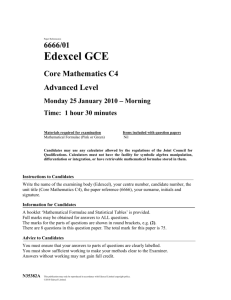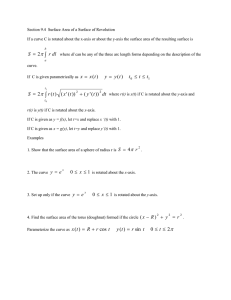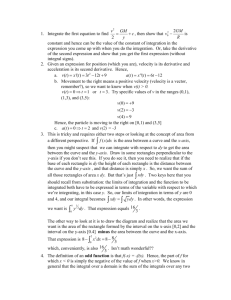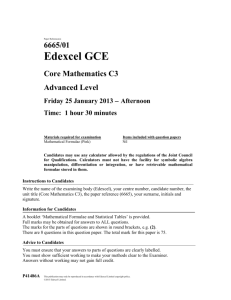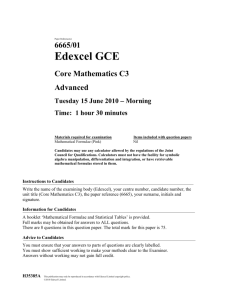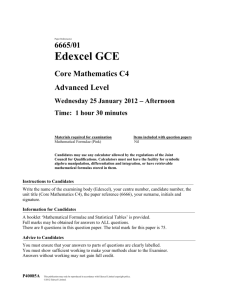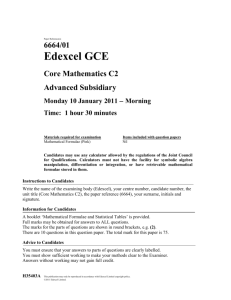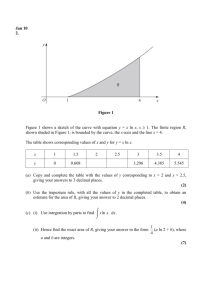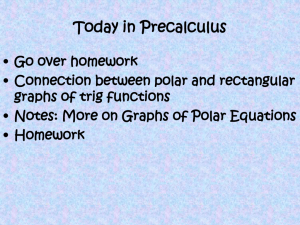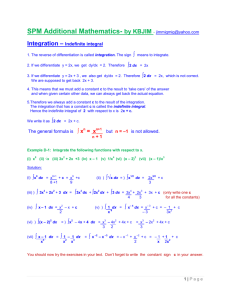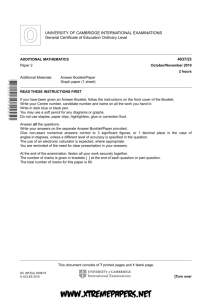Past paper - 6672 Pure P2 Jan 2005
advertisement
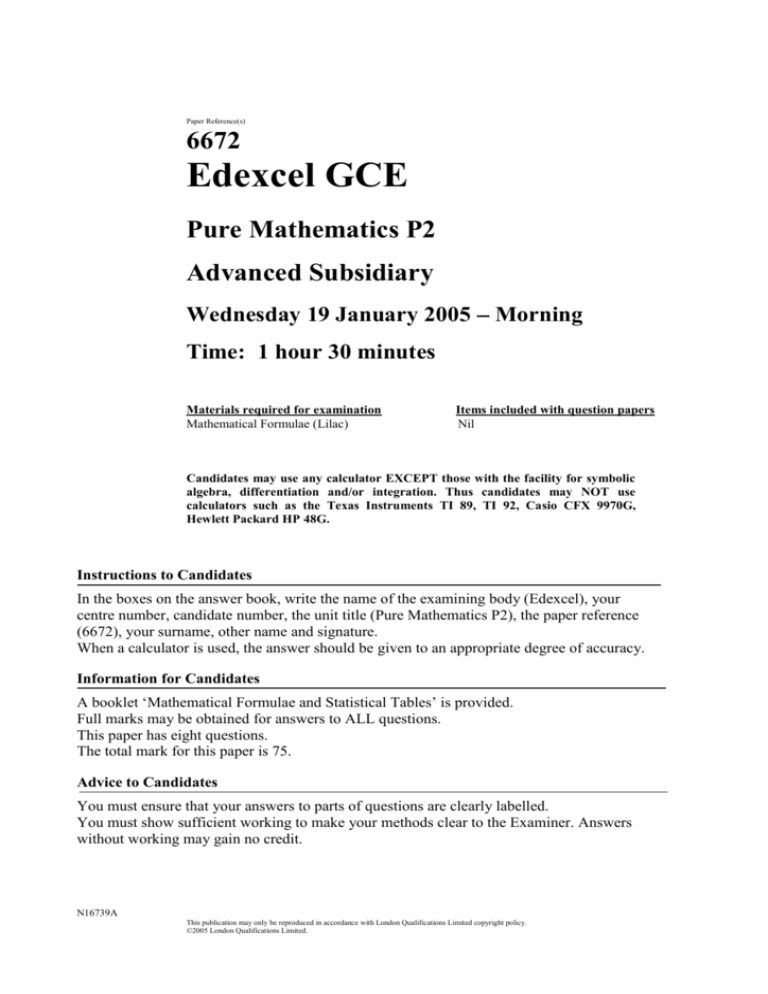
Paper Reference(s) 6672 Edexcel GCE Pure Mathematics P2 Advanced Subsidiary Wednesday 19 January 2005 Morning Time: 1 hour 30 minutes Materials required for examination Mathematical Formulae (Lilac) Items included with question papers Nil Candidates may use any calculator EXCEPT those with the facility for symbolic algebra, differentiation and/or integration. Thus candidates may NOT use calculators such as the Texas Instruments TI 89, TI 92, Casio CFX 9970G, Hewlett Packard HP 48G. Instructions to Candidates In the boxes on the answer book, write the name of the examining body (Edexcel), your centre number, candidate number, the unit title (Pure Mathematics P2), the paper reference (6672), your surname, other name and signature. When a calculator is used, the answer should be given to an appropriate degree of accuracy. Information for Candidates A booklet ‘Mathematical Formulae and Statistical Tables’ is provided. Full marks may be obtained for answers to ALL questions. This paper has eight questions. The total mark for this paper is 75. Advice to Candidates You must ensure that your answers to parts of questions are clearly labelled. You must show sufficient working to make your methods clear to the Examiner. Answers without working may gain no credit. N16739A This publication may only be reproduced in accordance with London Qualifications Limited copyright policy. ©2005 London Qualifications Limited. 1. f(x) = x2 x 6 , x 0, x 3. x 2 3x (a) Express f(x) in its simplest form. (3) (b) Hence, or otherwise, find the exact solutions of f(x) = x + 1. (3) 2. Figure 1 y O (1, 0) (4, 0) x (0, –2) Figure 1 shows a sketch of the curve with equation y = f(x), 0 x 4. The curve passes through the point (1, 0) on the x-axis and meets the y-axis at the point (0, –2). Sketch, on separate axes, the graph of (a) y =f(x), (2) (b) y = f(2x), (2) (c) y = f–1(x), (3) in each case showing the coordinates of the points at which the graph meets the axes. N16739A 2 3. The sequence u1, u2, u3, ... , is defined by the recurrence relation un + 1 = (–1)n un + d, u1 = 2, where d is a constant. (a) Show that u5 = 2. (4) (b) Deduce an expression for u10, in terms of d. (1) Given that u3 = 3u2, (c) find the value of d. (2) 4. Figure 2 y (0, 8) l R A O x Figure 2 shows part of the curve with equation y = x2 + 4 and the line l with equation y = 8. The curve crosses the y-axis at the point A. (a) Write down the coordinates of A. (1) The shaded region R, which is bounded by the curve, the y-axis and the line l, is rotated through 360 about the y-axis. (b) Using calculus, calculate the volume of the solid generated, giving your answer in terms of . (6) N16739A 3 5. Find, giving your answer to 3 significant figures where appropriate, the value of x for which (a) 3x = 5, (3) (b) log2 (2x + 1) – log2 x = 2, (4) (c) ln sin x = –ln sec x, in the interval 0 < x < 90. (3) 6. The function f is defined by f: x 3 + 2ex, x ℝ. 1 (a) Evaluate f ( x) dx , giving your answer in terms of e. 0 (3) The curve C, with equation y = f(x), passes through the y-axis at the point A. The tangent to C at A meets the x-axis at the point (c, 0). (b) Find the value of c. (4) The function g is defined by g: x 5x 2 , x4 x ℝ, x > –4. (c) Find an expression for g–1(x). (3) (d) Find gf(0). (2) N16739A 4 7. Figure 3 B F G C 2 cm 2 cm E D 22 2 cm 2 cm A Figure 3 shows an isosceles triangle ABC with AB = AC = 4 cm and BAC = 2. The mid-points of AB and AC are D and E respectively. Rectangle DEFG is drawn, with F and G on BC. The perimeter of rectangle DEFG is P cm. (a) Show that DE = 4 sin . (2) (b) Show that P = 8 sin + 4 cos . (2) (c) Express P in the form R sin ( + ), where R > 0 and 0 < < . 2 (4) Given that P = 8.5, (d) find, to 3 significant figures, the possible values of . (5) N16739A 5 8. Figure 4 y O A x B C f(x) = 1 x – 1 + ln , x > 0. 2x 2 Figure 4 shows part of the curve with equation y = f(x). The curve crosses the x-axis at the points A and B, and has a minimum at the point C. (a) Show that the x-coordinate of C is 1 2 . (5) (b) Find the y-coordinate of C in the form k ln 2, where k is a constant. (2) (c) Verify that the x-coordinate of B lies between 4.905 and 4.915. (2) (d) Show that the equation 1 x 1 - 1 – 1 + ln = 0 can be rearranged into the form x = 2e 2 x . 2x 2 (2) The x-coordinate of B is to be found using the iterative formula xn + 1 = 2e 1 - 1 2 xn , with x0 = 5. (e) Calculate, to 4 decimal places, the values of x1, x2 and x3. (2) TOTAL FOR PAPER: 75 MARKS END N16739A 6
